1821 marked the high point of British coronation banquets. Held at Westminster Hall on the occasion of the coronation of King George IV (1762–1830), the 1821 edition was a colossal affair with hundred of guests arranged in three tiers above the main banqueting table. The bill of fare was truly extraordinary. One hundred and sixty tureens of soup were made – 80 of which contained turtles. Eighty venison joints were served, along with 40 of beef and 40 of mutton. Two hundred and forty lobsters were sacrificed to the pot, and 1,600 chickens lost their lives. Those guests seated in the upper tiers did not eat – they were there simply to watch the gluttonous festival.
Perhaps embarrassed by the sheer scale of the 1821 event, no subsequent monarch has ever held a full-on banquet to commemorate their crowning.
In 1953, the contrast could not have been more stark. Quietly spoken posh girl Princess Elizabeth (1926–) had succeeded to the throne on the premature death of her chain-smoking father the year before. Britain was 8 years out of World War II (we won) and food rationing was still in very much in force. The civilian population was allowed weekly rations of 113g of bacon, 227g sugar, a shilling’s worth of meat (about £2.50 in today’s money), and 57g of butter (a quarter pat).
The food-based celebrations of the The Queen’s coronation were many, but modest. There was a luncheon at 2pm on the day of the coronation. This was hosted by The Queen for 350 people in the Great Hall of Westminster School, just 3 minutes walk from the Abbey. In the evening, the Royal Family had a simple steak dinner with an ice cream dessert. The following two days featured two separate banquets hosted at Buckingham Palace where guests tucked into soup, sole, rack of lamb, veg and strawberries.

But, let’s wind back to that luncheon on the day of the crowning and deal with a piece of misinformation that has crept into some historical records. The main dish in the lunch served to The Queen and guests on that day in 1953 was known as ‘poulet Reine Elizabeth‘ (the British Royal Family consistently use French on their menus), and is now more commonly known as ‘coronation chicken.’ A contemporary cook book was published under the title The Constance Spry Cookery Book, and it contained coronation chicken. That is where a little myth came to be:
- Myth: Coronation chicken was adapted from jubilee chicken (George V, 1935) by Le Cordon Bleu principal Constance Spry (1886–1960) as a cold dish that could be prepared in advance for people wishing to eat after watching the coronation on TV (this was the first televised coronation in history).
- Reality: The dish was conceived by Le Cordon Bleu co-principal Rosemary Hume (1907–1984) for the coronation luncheon. Angela Wood was asked to refine and perfect the idea of a creamy, mild chicken curry. Spry later put the recipe in her own cookbook, which was actually co-authored with Hume.
On its own web site, Le Cordon Bleu school is very clear on the provenance of poulet Reine Elizabeth. The school states that Conservative MP Sir David Eccles (1904–1999), Minister of Works, commissioned Le Cordon Bleu London to make the coronation luncheon. Specifically, he asked for Rosemary Hume to do it with her band of students. So, that’s that.
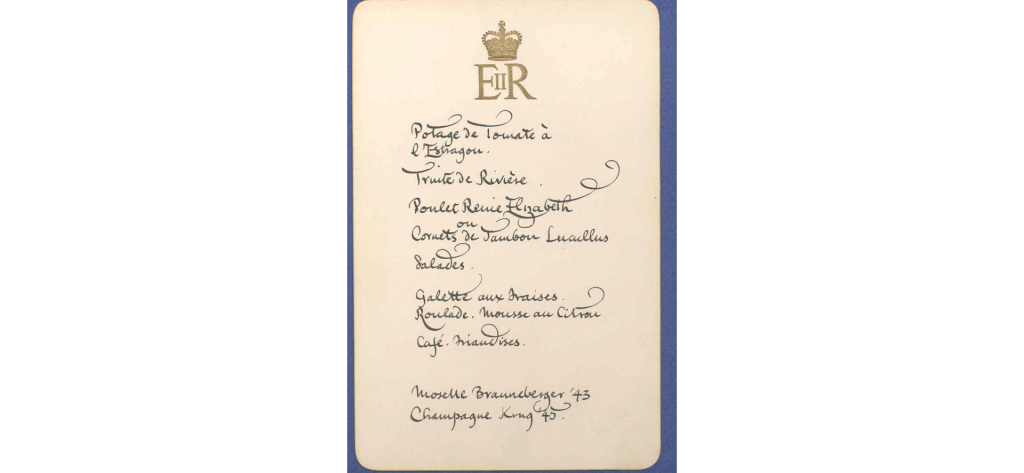
Although poulet Reine Elizabeth is quite a simple dish, its position on the British curry timeline means that preparing it needs a bit of care. The dish comes from a period when the Brits were beginning to discover the delights of curry, but were by no means up for a Bombay arse burner. Also, with 350 posh people in sitting down to lunch, many, highly conservative tastes had to be accounted for. For these reasons, poulet Reine Elizabeth was prepared with a very mild curry flavour.
This is where the care is needed. When you cook this, the initial reduced sauce with the curry and lemon is quite ferocious and very sour. It is carefully added to mayonnaise and apricot purée, and this balances these two flavours out. You need to go on taste alone, and that is why Spry uses the term ‘by degrees’ when she describes her colleague’s recipe below.
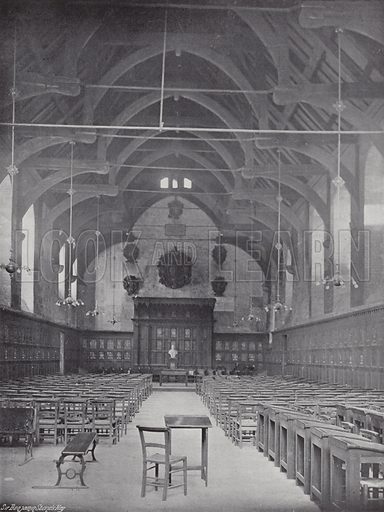
Poulet Reine Elizabeth
Ingredients
- For the chicken:
- One good-sized chicken (the original recipe calls for 2 'young' chickens)
- 1 carrot, split
- 1 bouquet garni
- 10 black peppercorns
- For the sauce:
- 1 tbsp oil
- 25g onion, finely chopped
- 1 dessert spoon curry powder
- 1 good tsp tomato purée
- 1 wine glass red wine
- Three quarters of a wine glass water
- A bay leaf
- Salt, sugar, a touch of pepper
- A slice or two of lemon and a squeeze of lemon juice
- 1–2 tbsp apricot purée (blanch, peel and stone the fruit, blitz, pass through a sieve)
- 450ml mayonnaise
- 2–3 tbsp lightly whipped cream
Instructions
To cook the chicken:
Put the chicken in a pot with the carrot, bouquet garni, and peppercorns. Cover with water, bring to the boil, reduce to a simmer lid and cook on low for 1.5 hours. Allow the chicken to cool in the pot with the water. Joint, bone and dice.
For the sauce:
Heat the oil in a frying pan, add the onion, cook gently for 3–4 minutes, add curry powder. Cook again for 1–2 minutes.
Add the tomato purée, wine, water and bay leaf. Bring to boil, add salt, sugar to taste, pepper, and the lemon and lemon juice. Simmer with the pan uncovered for 5–10 minutes.
Strain and cool. Add by degrees (see comment in article above) to the mayonnaise with the apricot purée to taste.
Adjust seasoning, adding a little more lemon juice if necessary. Finish with the whipped cream. Take a small amount of sauce (enough to coat the chicken) and mix with a little extra cream and seasoning.
Mix the chicken and the sauce together, arrange on a dish, coat with the extra sauce. This dish is served at room temperature.
Notes
The rice salad which accompanied the chicken was of rice, peas, diced raw cucumber and finely chopped mixed herbs, all mixed in with a well-seasoned French dressing (oil, vinegar and Dijon mustard). For convenience in serving at the coronation luncheon, the chicken was arranged at one end of an oblong dish and a rice salad at the other. Economic types can break down the remaining chicken carcass, put it back in the poaching water and simmer down to make a litre or so of stock.




 (22 votes, average: 3.68 out of 5)
(22 votes, average: 3.68 out of 5)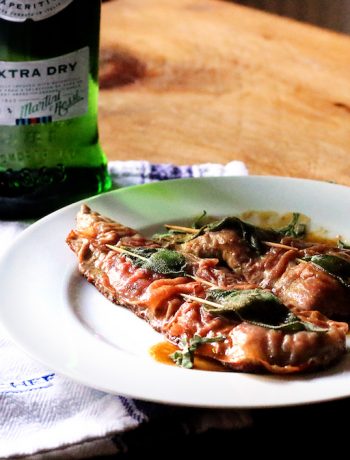
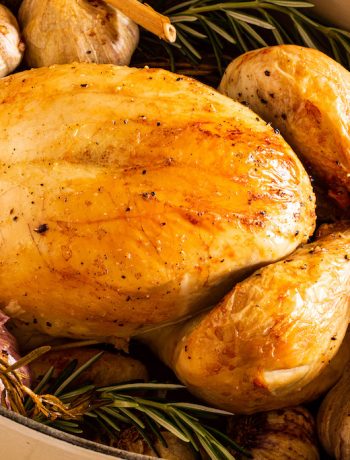
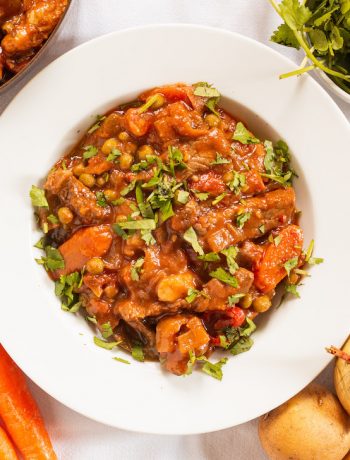
5 Comments
Shannon
12/05/2022 at 11:03 pmWonderful recipe, thank you. However, your myth-busting is incorrect. This recipe was created Angela Wood, who was a Cordon Bleu cookery school student when she was asked to perfect the dish for the Queen’s Coronation Day banquet. The school was asked to create the dish and Founders Constance Spry and Rosemary Hume decided a cold chicken dish coated in a curried creamy sauce would be “really easy to serve.”
Source: https://www.bbc.co.uk/news/uk-england-cambridgeshire-60065982
Nigel Eastmond
02/06/2022 at 7:34 pmYou are right I edited the piece.
Mrs Jean Bellis
03/06/2022 at 4:52 pmAs the Queen does not eat,onions, I doubt onions were included in the recipe for Poulet Reine Elizabeth. I have an authentic recipe for Coronation Chicken (as it became known) & there is no mention at all of,onions in it
Nigel Eastmond
03/06/2022 at 7:29 pmMaybe the Queen does not eat onions now, but she had them in this sauce. The Cordon Bleu references and every original record of this dish includes the onions. They are used as flavouring and are discarded in the process. The recipe you have cannot be the actual Spry/Hume/Wood original. Sorry.
It is also true that the preferences of the Queen in her food tastes are not down to what she does like, but rather to what is practical. The two items that her chef is on record as saying she definitely does not eat are shellfish and garlic. Onion, as you say, also makes the list. This has more to do with not falling ill and/or having interesting breath when travelling or meeting dignitaries than it has to do with taste. Queen Elizabeth II was only in the early stages of all that diplomatic fuss when she was crowned in 1952. I stand by the onions, as does Ms Wood.
Poulet Reine Elizabeth – Recipe Me
11/02/2023 at 3:17 pm[…] Read More […]